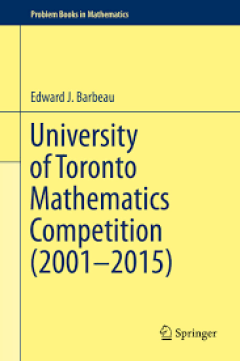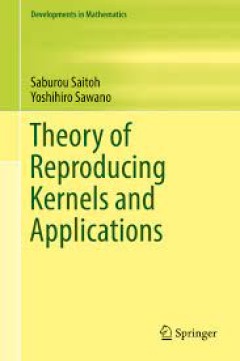Filter by

A Generalization of Bohr-Mollerup's Theorem for Higher Order Convex Functions
Pada tahun 1922, Harald Bohr dan Johannes Mollerup membuat karakterisasi fungsi gamma Euler yang luar biasa menggunakan sifat log-konveksitasnya. Satu dekade kemudian, Emil Artin menyelidiki hasil ini dan menggunakannya untuk memperoleh sifat dasar fungsi gamma menggunakan metode dasar kalkulus. Teorema Bohr-Mollerup kemudian diadopsi oleh Nicolas Bourbaki sebagai titik awal untuk pemaparannya …
- Edition
- 1
- ISBN/ISSN
- 978-3-030-95088-0
- Collation
- 1 online resource ( XVIII, 323 Pages)
- Series Title
- -
- Call Number
- 515.5 MAR g

A Generalization of Bohr-Mollerup's Theorem for Higher Order Convex Functions
In 1922, Harald Bohr and Johannes Mollerup established a remarkable characterization of the Euler gamma function using its log-convexity property. A decade later, Emil Artin investigated this result and used it to derive the basic properties of the gamma function using elementary methods of the calculus. Bohr-Mollerup's theorem was then adopted by Nicolas Bourbaki as the starting point for his …
- Edition
- 1
- ISBN/ISSN
- 978-3-030-95088-0
- Collation
- -
- Series Title
- Developments in Mathematics
- Call Number
- XVIII, 323

Advances in large margin classifiers
The concept of large margins is a unifying principle for the analysis of many different approaches to the classification of data from examples, including boosting, mathematical programming, neural networks, and support vector machines. The fact that it is the margin, or confidence level, of a classification--that is, a scale parameter--rather than a raw training error that matters has become a …
- Edition
- -
- ISBN/ISSN
- 9780262283977
- Collation
- 1 online resource (vi, 412 pages) :illustrations.
- Series Title
- -
- Call Number
- -

Predicting structured data
Collected papers based on talks presented at two Neural Information Processing Systems workshops.State-of-the-art algorithms and theory in a novel domain of machine learning, prediction when the output has structure.Machine learning develops intelligent computer systems that are able to generalize from previously seen examples. A new domain of machine learning, in which the prediction must sati…
- Edition
- -
- ISBN/ISSN
- 9780262255691
- Collation
- 1 online resource (viii, 348 pages) :illustrations.
- Series Title
- -
- Call Number
- -

Learning with kernels :support vector machines, regularization, optimization,…
In the 1990s, a new type of learning algorithm was developed, based on results from statistical learning theory: the Support Vector Machine (SVM). This gave rise to a new class of theoretically elegant learning machines that use a central concept of SVMs -- -kernels--for a number of learning tasks. Kernel machines provide a modular framework that can be adapted to different tasks and domains by…
- Edition
- -
- ISBN/ISSN
- 9780262256933
- Collation
- 1 online resource (xviii, 626 pages) :illustrations.
- Series Title
- -
- Call Number
- -

Kernel methods in computational biology
"A Bradford book."Modern machine learning techniques are proving to be extremely valuable for the analysis of data in computational biology problems. One branch of machine learning, kernel methods, lends itself particularly well to the difficult aspects of biological data, which include high dimensionality (as in microarray measurements), representation as discrete and structured data (as in DN…
- Edition
- -
- ISBN/ISSN
- 0262256924
- Collation
- 1 online resource (ix, 400 pages) :illustrations.
- Series Title
- -
- Call Number
- -

University of Toronto Mathematics Competition (2001–2015)
This text records the problems given for the first 15 annual undergraduate mathematics competitions, held in March each year since 2001 at the University of Toronto. Problems cover areas of single-variable differential and integral calculus, linear algebra, advanced algebra, analytic geometry, combinatorics, basic group theory, and number theory. The problems of the competitions are given in ch…
- Edition
- -
- ISBN/ISSN
- 978-3-319-28106-3
- Collation
- -
- Series Title
- -
- Call Number
- -

The Real and the Complex: A History of Analysis in the 19th Century
This book contains a history of real and complex analysis in the nineteenth century, from the work of Lagrange and Fourier to the origins of set theory and the modern foundations of analysis. It studies the works of many contributors including Gauss, Cauchy, Riemann, and Weierstrass. This book is unique owing to the treatment of real and complex analysis as overlapping, inter-related subject…
- Edition
- 1
- ISBN/ISSN
- 978-3-319-23715-2
- Collation
- Mathematics
- Series Title
- Springer Undergraduate Mathematics Series
- Call Number
- 510

The Real and the Complex: A History of Analysis in the 19th Century
This book contains a history of real and complex analysis in the nineteenth century, from the work of Lagrange and Fourier to the origins of set theory and the modern foundations of analysis. It studies the works of many contributors including Gauss, Cauchy, Riemann, and Weierstrass. This book is unique owing to the treatment of real and complex analysis as overlapping, inter-related subject…
- Edition
- 1
- ISBN/ISSN
- 978-3-319-23715-2
- Collation
- XVI, 350, 71 b/w illustrations
- Series Title
- Springer Undergraduate Mathematics Series
- Call Number
- -

Theory of Reproducing Kernels and Applications
This book provides a large extension of the general theory of reproducing kernels published by N. Aronszajn in 1950, with many concrete applications. In Chapter 1, many concrete reproducing kernels are first introduced with detailed information. Chapter 2 presents a general and global theory of reproducing kernels with basic applications in a self-contained way. Many fundamental operations amo…
- Edition
- -
- ISBN/ISSN
- 978-981-10-0530-5
- Collation
- -
- Series Title
- -
- Call Number
- -
 Computer Science, Information & General Works
Computer Science, Information & General Works  Philosophy & Psychology
Philosophy & Psychology  Religion
Religion  Social Sciences
Social Sciences  Language
Language  Pure Science
Pure Science  Applied Sciences
Applied Sciences  Art & Recreation
Art & Recreation  Literature
Literature  History & Geography
History & Geography